A Recipe for Food Justice
Food is more than sustenance. The foods we eat and how they are made can speak volumes about the cultures and histories that brought them to life.
Sancocho, a traditional Puerto Rican stew, is lovingly prepared from commonly found ingredients that, when brought together, magically transform into a satisfying and nourishing meal that can feed a whole community.
Though sofrito serves as the seasoning base for the recipe, ingredients will vary from table to table adapting to what is readily available. But even then, the hearty stew will always have bits of carne (beef), plátano (plantain), yucca (cassava root) y maiz (corn) simmering away in the caldero (pot). Together, each of these ingredients will fill homes with a delightful, and for many, a nostalgic aroma.
However, our constantly simmering pot of ingredients is no longer locally produced. Colonialism has always centered on the exploitation and destruction of food systems through forced or cheap labor. As the oldest colony in the world, it is intelligible that 85 percent of the island’s food is sourced outside Puerto Rico, including agricultural goods that once grew abundantly on the island. Thus, grocery dollars spent continue to exit the country instead of circulating and strengthening its local economy.
While it is highly unlikely that Puerto Rico will ever be able to produce all of its own food, a multiplicity of non-government organizations (NGOs) are working hard to decrease dependence on foreign importation and strengthen agroecological farming practices. Through the humble practice of making sancocho, we trace back the places where ingredients have traveled from and explore the current hegemonic structures that dominate Puerto Rico’s food production. Further, we aim to elevate non-government agencies that are seeking to change it through collective action and radical transparency.
1. Season pieces of beef. Dredge in flour and sear.
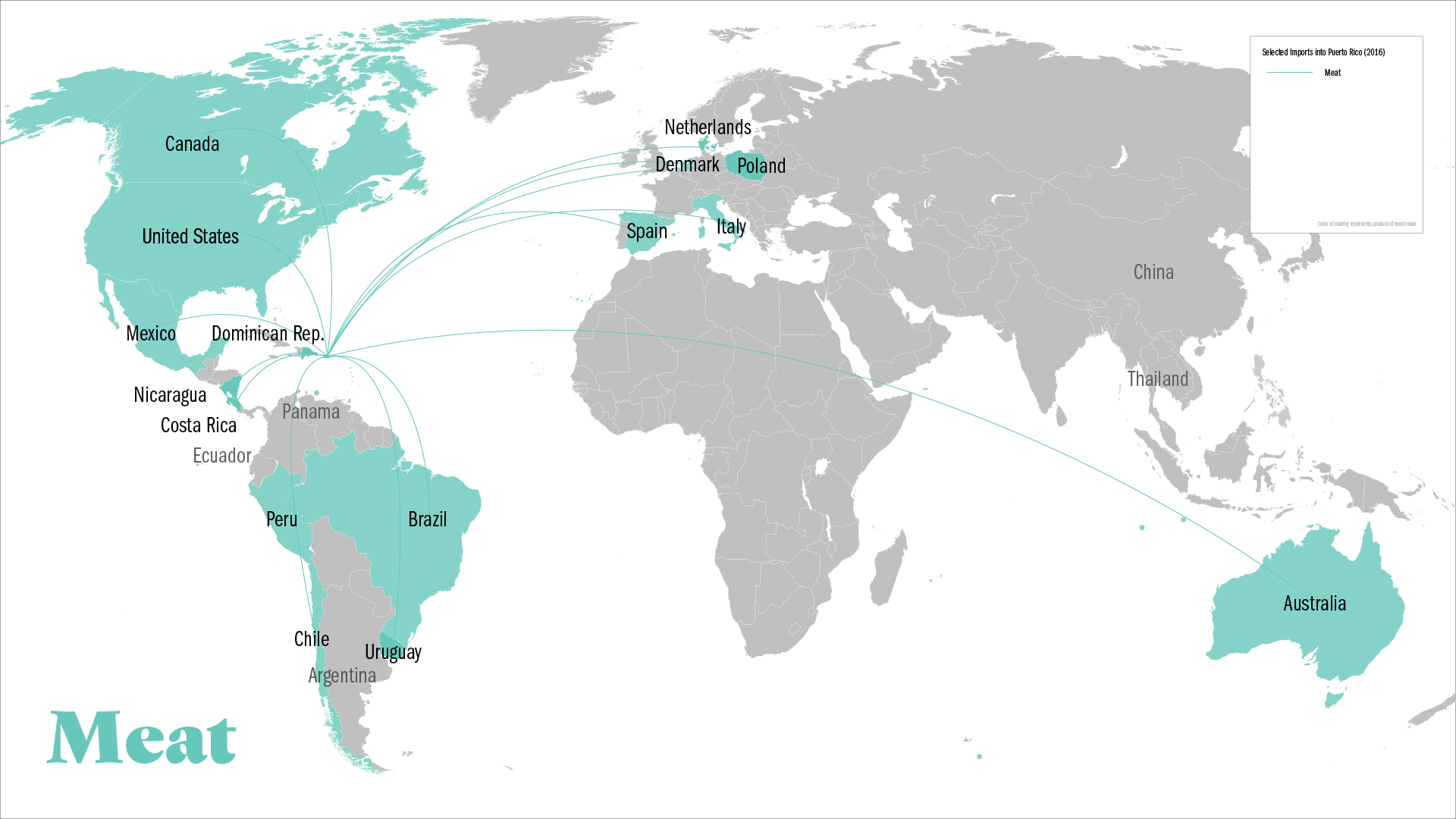 Meat Import Map
Meat Import MapSancocho is commonly made with beef and pork proteins. In 2016, Puerto Rico imported approximately 890 million US dollars worth of cow and pig-based meats from fourteen different countries. While some of the beef is being imported from Central America, a surprising 100 thousand kilograms of it travels from the distant land of Australia.
Such massive imports of meat came about with the industrialization of the island in the 1950s. Not only did mass importation drastically change how and what Puerto Ricans ate, but it also restricted where food could be purchased. Farmers in rural areas begin migrating to urban areas for new work. Food imports began arriving from the United States to compensate for the reduction in local agricultural labor and production. This lead to the introduction of supermarkets that touted mainland American goods, and ultimately, implemented a longstanding change in Puerto Ricans’ diets.
Historic accounts of food in Puerto Rico rarely mentioned the consumption of meat. However, the implementation of supermarkets all across the island increased ease of access to meats, processed foods, and indiscriminately decreased the variation in produce. Today, we see that approximately 43 percent of islanders receive food stamps from the government and are required to shop at authorized supermarkets that have limited variety of food and with little or no stock of local produce.
2. Add sofrito, onion, garlic, and sweet peppers. Cook until onion is translucent.
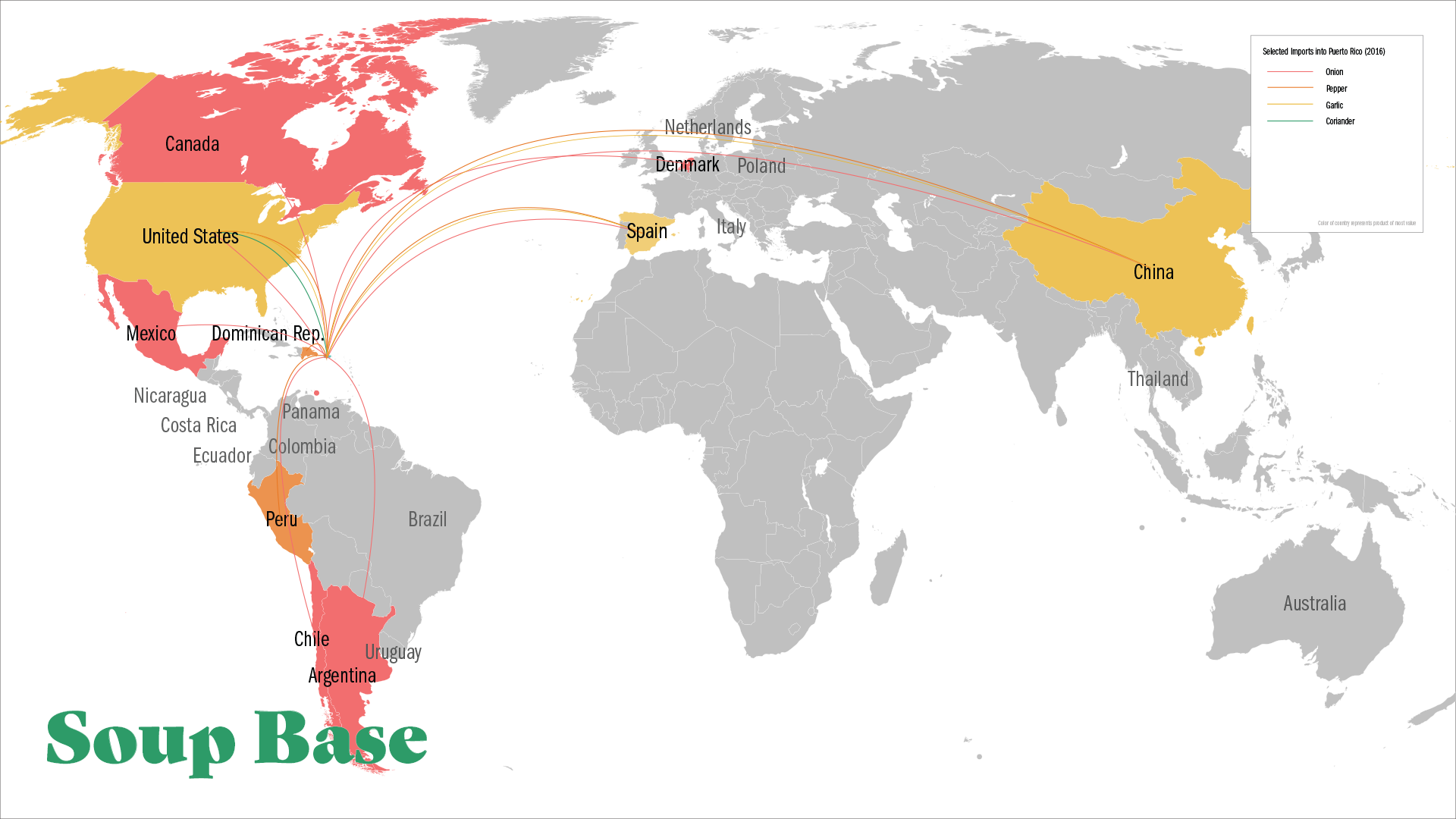 Sofrito Import Map
Sofrito Import MapSofrito is a Puerto Rican seasoning base made of garlic, cilantro, culantro, onions, and sweet peppers. This can be found in almost every home refrigerator making it a seasoning that exists at the epicenter of Puerto Rican cuisine. Garlic, originally introduced by the Spanish, does not appear to be grown locally. In 2016, 3.5 million kilograms of garlic valued at 7.5 million US dollars was imported to make up for this dearth. Additionally, 16 million US dollars worth of onions and onion products were brought in from places as far as Canada, China, and Denmark.
The compounding price spent on imported foods continues to be alarming. But, it’s important to note it as a byproduct of colonization capitalistic interest in land production. Decades before the industrialization of the island, the US provided sugar production incentives to industrial farmers who would be growing their crops in Puerto Rico. This lead to the overturn of agriculturally diverse lands into desolate areas meant for the management of a single crop; the monosolatecrop. Agriculture lands were shaped up to meet the demands of the global economy as opposed to the local food system.
3. Add broth and bring to a boil. Simmer to reduce.
Sancocho is both literally and figuratively a melting pot of Spanish, African and Taíno roots. During the Spanish rule of Puerto Rico, Africans were forcibly brought to the island to replace a rapidly decimating Taíno workforce. While enslaved Africans and Taíno worked the plantations at the hand of white masters, calderos of sancocho would simmer for hours over a fire breaking up tough pieces of meat and softening whatever was added to the pot that day.
Over the years, the stew would become to symbolize unity, strength, and celebration. Under Spain’s 400 hundred years of governance and control, uniquely Puerto Rican culture and identity materialized, so when the US invaded the island in 1898, they encountered a people whose sense of national identity had already been established. For example, in 1859, the first Puerto Rican cookbook had been published, El Cocinero Puertorriqueño, revealing the rich culture and traditions of puertorriquenos through tried-and-true family recipes.
At this time, though literacy rates were low, political awareness and participation were high. The US invasion coincidentally occurred five months after Spain had created the Autonomic Charter of 1897, the most liberal document ever written for a colony. It had given Puerto Ricans full representation and self-governance power, much more than what is presented today under US colonization. Puerto Ricans gained US citizenship under the Jones Act of 1917. But citizenship rights are limited. Puerto Ricans who live on the island are not allowed to vote for President nor do they have any representation in federal level policies.
4. Add Plátanos, yucca, carrots, and any other starchy or root vegetables you have on hand. Simmer until tender and thickened.
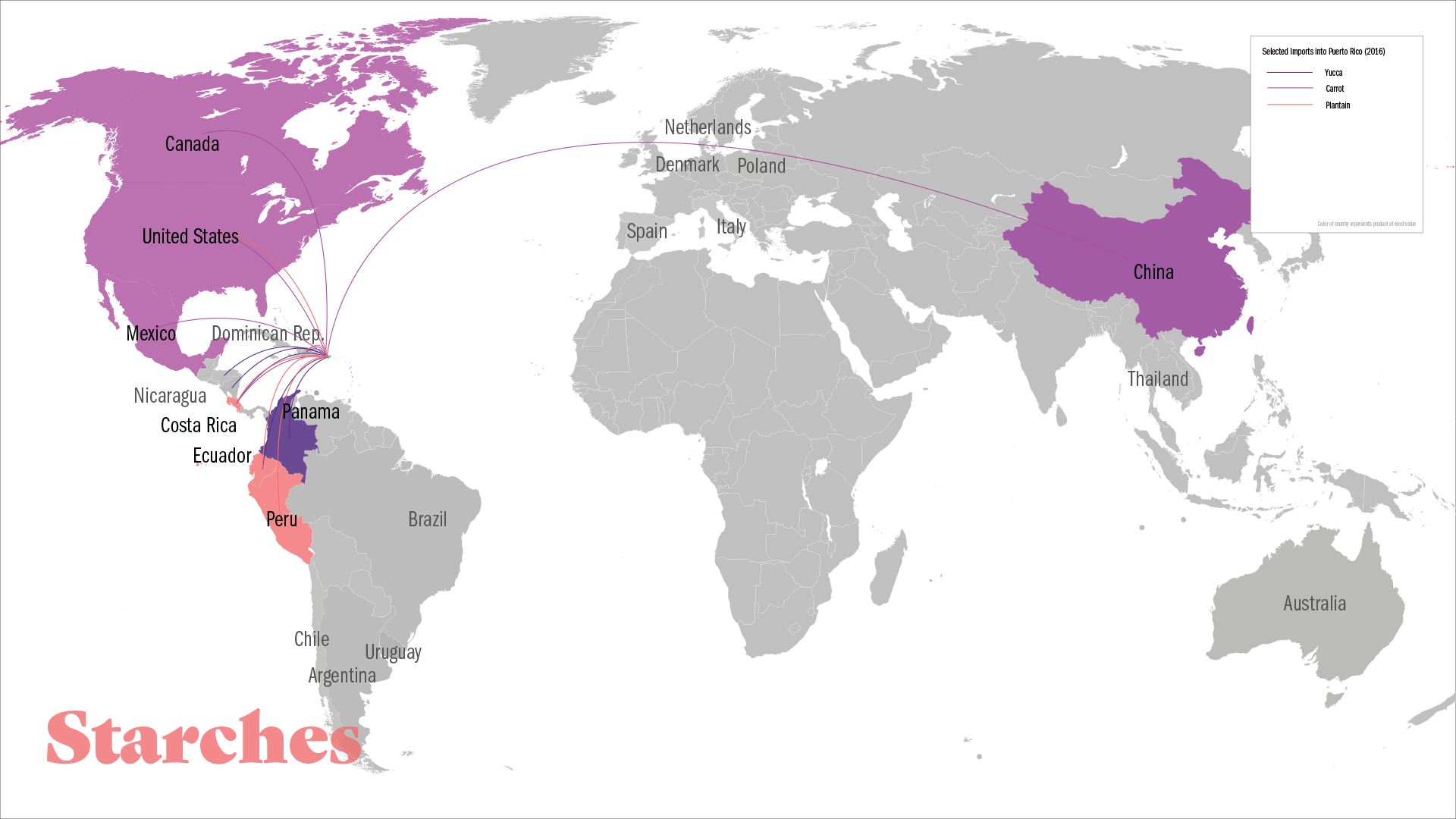 Starches Import Map
Starches Import MapA number of starchy fruits and vegetables fill the body of the sancocho and the bellies of millions. In fact, many people choose to forego any animal products and rely on the sweet and tender flavors of plátano, yucca, and carrot to fill them up. Just under 900 thousand kilograms of plantains valued at 1.3 million USD, over 2.2 million kilograms of yucca valued at over 1.5 million US dollars, and 3.6 million kilograms of carrots valued at just under 2.9 million US dollars were brought into Puerto Rico in 2016.
However, crops, such as plantain, yucca, and carrot, were seen as unprofitable and were replaced by large-scale mechanized agriculture, many of which were monoculture plantations that are simply in the business of making profits. Many negative consequences arise with the practice of growing one crop on large plots of land:
- The land is concentrated and kept in the hands of few
- Soil health is degraded and nutritionally deficient, decreasing production and increasing dependence on agro-chemicals that aid in growth and ward off diseases.
- Diseases that were not common on agriculturally diverse fertile lands were reintroduced.
- Agro-chemicals damage the natural ecosystem, polluting water airways, suffocating fish, and in large quantities damaging the health of local residents.
- Genetically modified seeds need to be purchased for each growing season unlike natural pollination processes
- Conventional farming costs can add up, leaving the small farmer with little to no profit.
Agro-ecology farming is an alternative model for industrial agriculture that is concerned with all aspects of food production. It is free of agro-chemicals and brings back traditional farming methods that enhance ecosystems. Not only is it concerned with how farming is done but with who farms. Inclusive farming focuses on knowledge and the sharing of that knowledge as well as the health of the societies it depends on. Agro-ecology, therefore, supports the connections between people and the environment making it an essential tool in achieving food sovereignty.
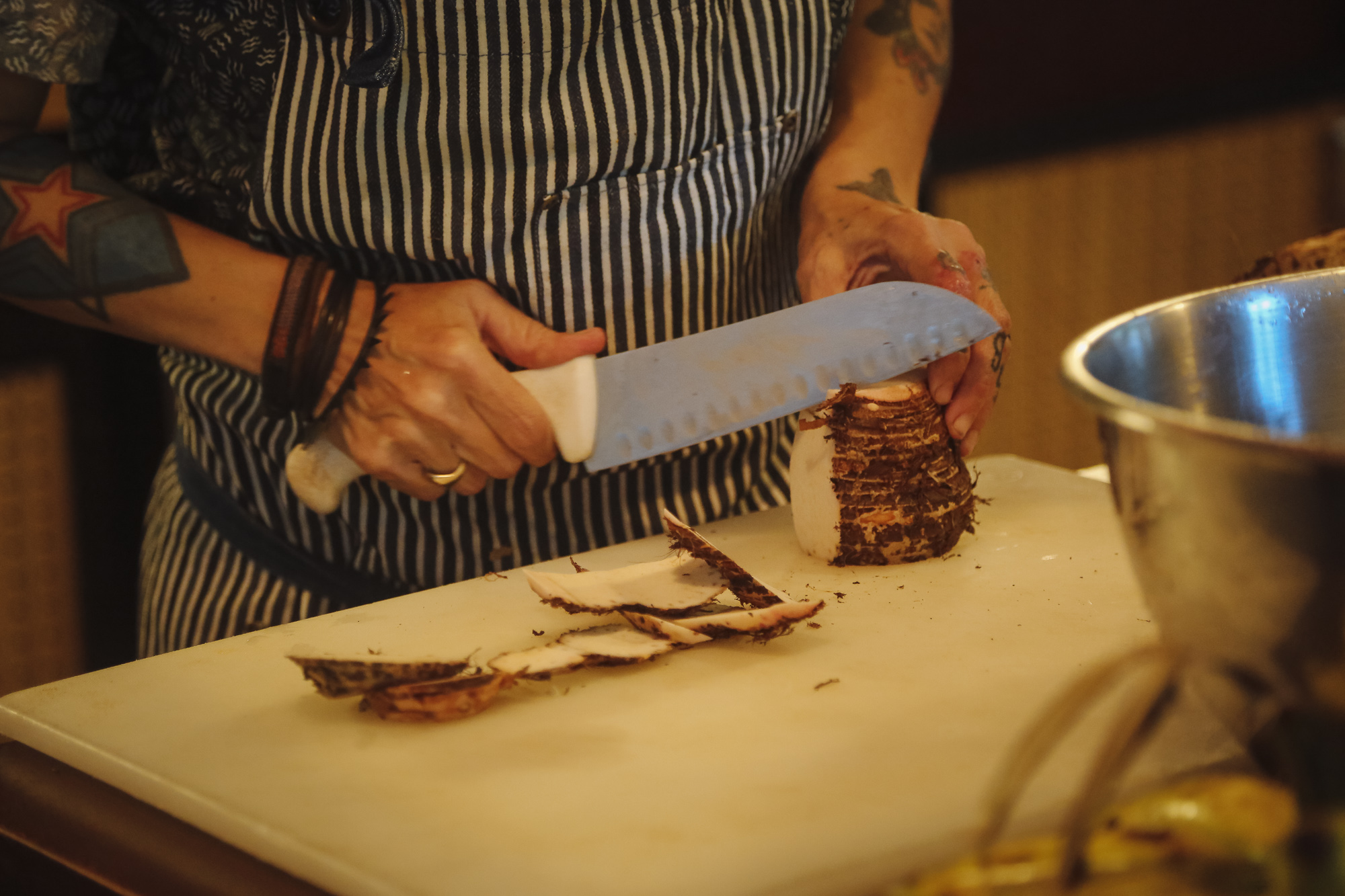 Person preparing yucca for cooking, Eater Magazine (2018)
Person preparing yucca for cooking, Eater Magazine (2018)5. Add Corn. Simmer until all the vegetables are soft.
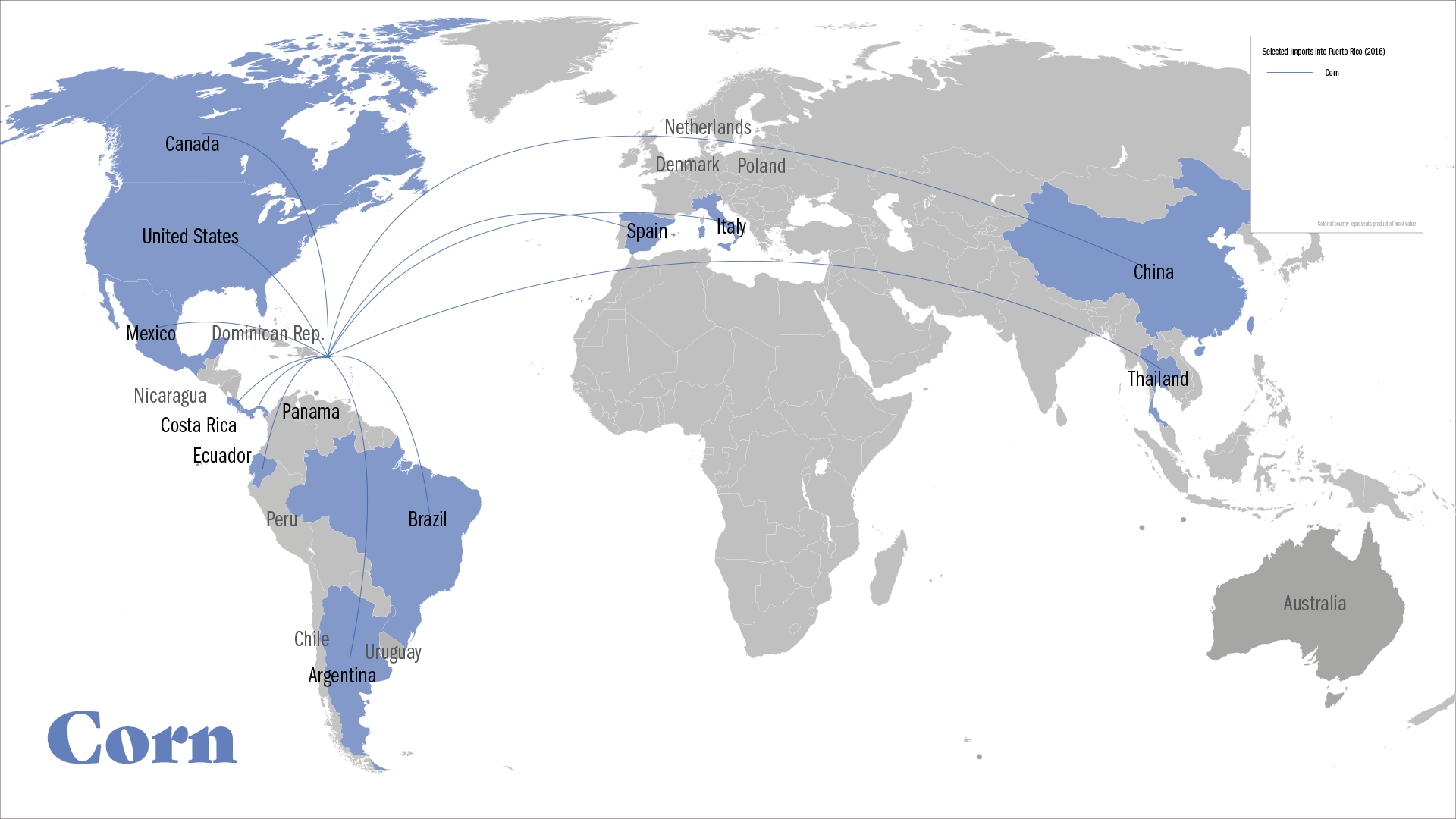 Corn Import Map
Corn Import MapAfter beef, corn is the second-largest food import of the ingredients of sancocho. Over 154 million kilograms of corn valued at 116 million USD are brought in a variety of forms including whole cobs, frozen kernels, canned nibs, oils, and flours. Puerto Rico has the ideal climate for growing corn, giving it three seasons in one year for harvest.
Knowing this condition of corn on Puerto Rico, Monsanto, a multi-national bio-technological seed corporation, scored big. The GMO seed producer and player in agro-technological experimentation receives extensive governmental benefits for their branch in Puerto Rico. along Multi-national seed corporations like Monsanto control just under 6,500 acres of the most fertile and arable lands in between Guayama and Juana Díaz. 44 percent of those lands are leased to these companies through the government and are used mainly for testing, not for the growing of food. Between 2006 and 2015, the transgenic seed and agro-chemical industry received more than 526 million dollars in subsidies and tax exemptions. The Puerto Rican government also refunds two dollars and 72 cents per hour of work paid by companies of unskilled laborers. Seed companies also get discounted rates on water sources from the Puerto Rico Electric Power Authority (PREPA), and will ultimately pay two dollars per acre-foot while other customers will pay from 163 and 325 dollars. All these benefits create a paradise for outside corporations to amass large amounts of wealth and damage local ecosystems. Their ability to extract wealth for Puerto Rico is made possible with through these nefarious government alliances, thus true agricultural revival and independence will not be achieved through regulatory efforts as evidenced by the quote below.
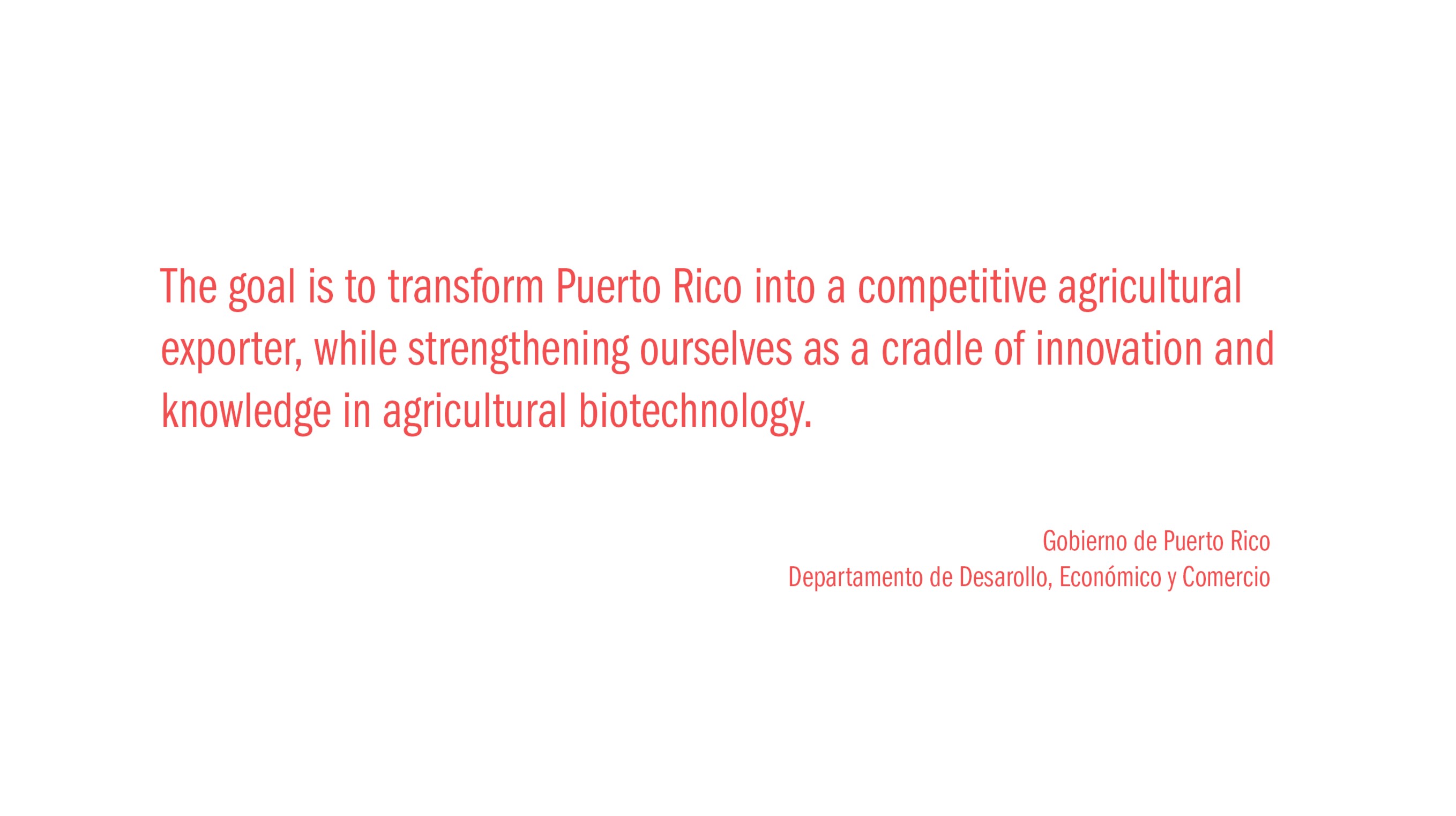
6. Garnish with cilantro. Eat with your community.
Fresh cilantro is added to brighten the stew before serving. In 2016, 35 thousand kilograms of coriander seeds used to grow cilantro were imported at a total cost of 70 thousand dollars.
Cilantro is but a pittance of what gets brought into Puerto Rico. In 2016 alone, over one billion US dollars were spent on the select ingredients highlighted in this research. We believe these dollars could have made a positive contribution to the local economy had they been spent in ways that supported the local food system. Thus we have identified Puerto Ricans that are seeking to change the power dynamic by empowering those in their communities and placing them at the center of the food system. They continue to gather and collaborate with other grass root industries, creating the forces needed for radical transformation and decolonization.
TThe seeds of change are being cultivated by Puerto Ricans NGOs, food projects, and businesses that are focused on reversing the damage done to their local food system. Agro-ecological principles are at the core of grassroots agricultural organizations such as Cooperativa Organica Madre Tierra, La Organización Boricuá de Agricultura, Siembra Boricua, Taina Soy Apiario, and El Departamento de La Comida, all of whom are working to remove colonial structures of food production and give agency to local Puerto Rican farmers and residents in their food-purchasing decisions. Together, these NGOs have established seed banks, increased distribution of local produce, helped create new eco-farming systems for farmers, designed school gardens, involved students for learning opportunities, saved beehives, sourced non-governmental funding, supported entrepreneurs and so, so much more.
These organizations are primarily led by women and queer people, who are organizing to dismantle the political and historical processes that have made Puerto Rico so dependent on food importation.
At many of their meetings, you may find them nourishing one another with bowls of sancocho, practicing their culinary traditions and creating new recipes for food justice.
So, How many Countries does it take to make Sancocho?
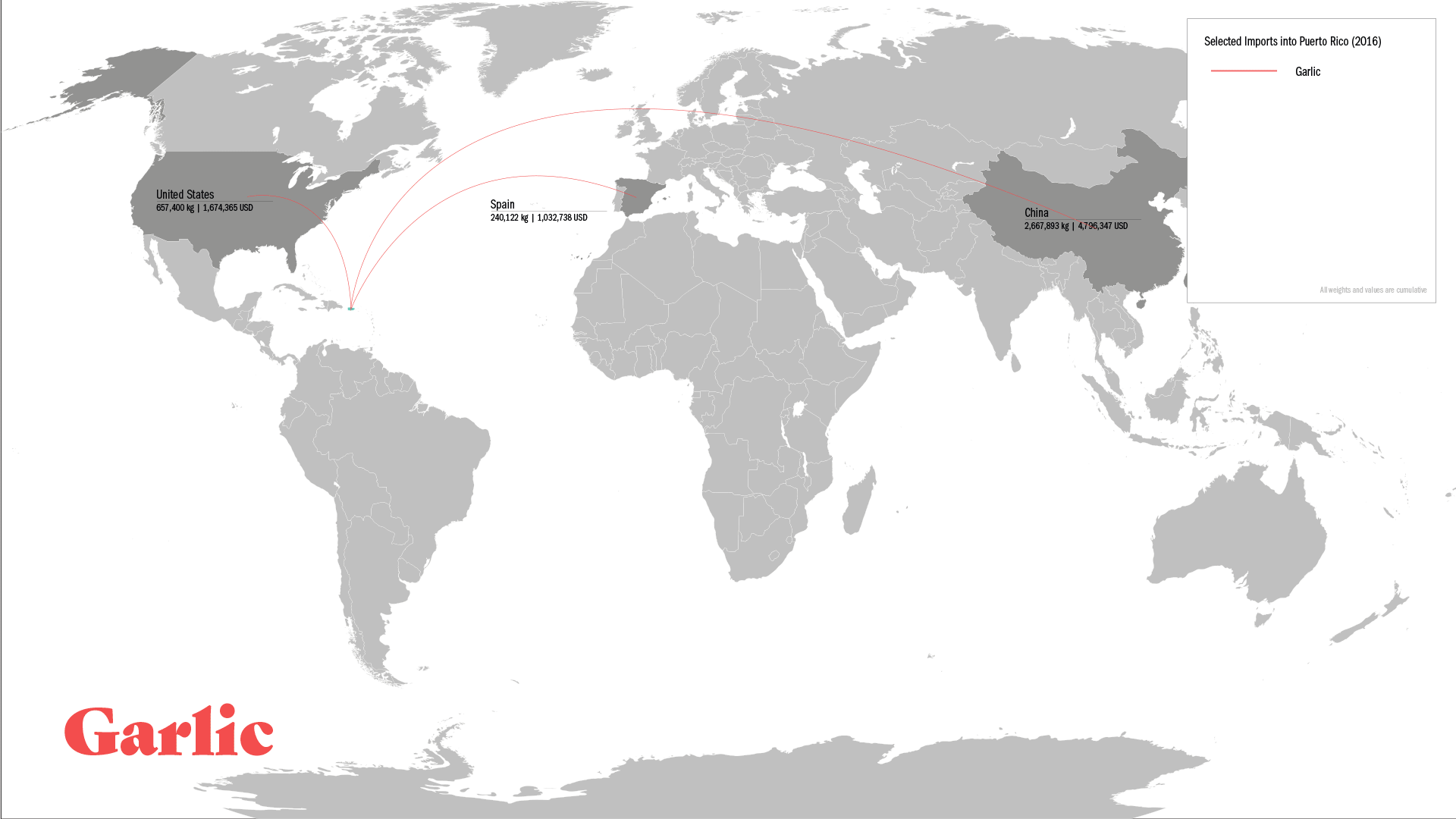 Sancocho Ingredients Import Map
Sancocho Ingredients Import MapData revealed that in 2016, 23 countries were sourced for ingredients commonly used in the making of sancocho. Though we were able to find this collection of data, an extensive report outlining what the 85 percent of food imports includes or excludes is not readily available.
While the countries that were exporting were found, it was impossible to calculate the number of miles traveled per food because the farms where produce was grown and the ports through which the food travelled were aggregated. We know that under the Jones Act of 1917, all imports are required to stop at a US port and goods are transferred to US cargo ships before arriving in Puerto Rico.
Can Food Sovereignty be achieved without Political Sovereignty?

It is clear amongst Puerto Ricans that the current political status is both antiquated and deificient at handling the agricultural industry of the island. The existing governmental structures favor top-down approaches to agricultural production, placing dollars in pockets of large corporations. Though it is unclear what alternative political governance may look like, we know that non-governmental organizations are essential to the dismantling of colonial structures as their bottom-up approach genuinely works towards food sovereignty. Though, they have made significant strides in fixing the ills of the past, many of these organizations need funding to continue their work thus complete food sovereignty will continue to be challenged by the complicated political status of Puerto Rico.
Detecting the Pulse of Local Agriculture from a Distance
The map below shows locations and profiles of farms, farmers markets, and businesses dedicated to strengthening the local food system and economy. While it is incomplete, it is a visual reminder of the sproutings of food justice across the island. We hope that this map will serve as a tool for advocates to network and strengthen their communities. We also hope that the map will serve as a visual for Puerto Rican consumers who live on and off the island. 1. That they support and see the benefit in supporting local efforts daily. 2. Provide alternative tourism attractions.
Limitations in our map are due to restrictions in locating spatial data that could be analyzed in GIS, geographic information system. This includes identifying agricultural land use, ownership of lands, and a collection of existing farms and their practices. Collaboration with Professors Alexa Dietrich of Wagner College and Adriana Garriga-Lopez of Kalamazoo College have helped us lay the groundwork on farming communities in Puerto Rico. Through intense research and informal interviews with Puerto Ricans, including one of the founders of the Departamento de la Comida, Tara Rodríguez Besosa we gained a better understanding of the agricultural landscape and challenges faced.
Other locations which fit this project’s narrative were identified through manually scraping Facebook pages and reviewing posted content. If a project or business had an online presence, recent activity, was focused on economic or agro-ecological principles, and made location public, then they were added to the map. Yielding 33 farm locations, 10 farmers markets, and six miscellaneous businesses.
We are led to believe that there are over 200 farms and organizations that meet these criteria and could potentially be mapped. However, it has been brought to our attention that many of them are purposely not made public and prefer to be private. A mistrust of project intentions is evident and understandable considering the unjust history and current political structures. A further detailed map will require on the groundwork by a local and trusted resident.
Like this project, sancocho is meant to be shared with others. Sancocho is the culmination of the ingenuity of slaves and native peoples, the celebrations of cultural milestones and achievements, and a icon for the resilient nature of Puerto Rico. It is etched on the hearts and in the bellies of those who cherish their Puerto Rican identities and cultures and work to preserve it.
Ways to Support…
1. Visit a local Farm on your next trip
2. Look for these organizations on the Map and follow them on Facebook
3. Vote on behalf of the Puerto Ricans on the island
 Illustration of local agriculture and community support, K. Lynch (2018)
Illustration of local agriculture and community support, K. Lynch (2018)